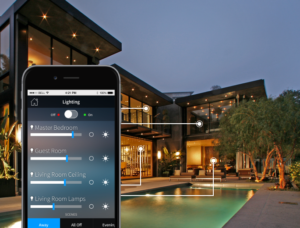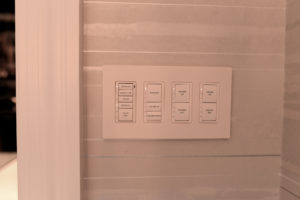Making Your Home Smarter with Lighting
Lighting control systems have evolved rapidly and increased in popularity over the past few years. According to data from the Consumer Technology Association (CTA) and the National Association of Home Builders (NAHB), more than two-thirds of all homebuilders offered automated lighting controls as an amenity in their newly constructed homes in 2015. Lighting control systems offer many benefits in terms of aesthetics, convenience, safety, security and energy management. These systems are easily compatible with smart phones, tablets and computers.
There are two basic kinds of lighting control systems:
Centralized
Typically found in new construction, a centralized system is comprised of low voltage keypads, and all electrical circuits are run to large electrical panels.
Decentralized/Wireless
Decentralized or wireless lighting control systems are typically used in existing homes. A licensed electrician installs “smart switches” to replace existing dimmers or switches.
Lighting control systems offer the following benefits:

Control your lights from your phone. Image courtesy of Crestron
Convenience and Safety
Imagine arriving at your home late at night with an armful of groceries. Without a lighting system, you will likely be trying to turn on successive lights while balancing bags. With a lighting system, simply press “Home” from your smart phone and have certain lights illuminate a path. Functions such as “all on” can quickly turn on all the lights in the home when needed. For example, in the case of an emergency. Also, adding an occupancy sensor in the bedroom or upstairs hallway helps to protect from tripping and falling during the night. If motion is detected, the occupancy sensor tells the lights to turn on at 10% in the hallway, stairs and perhaps the bathroom.
Aesthetics

Cut down on wall clutter. One consolidated location contains lighting control, dimmers, shade control and music volume.
It’s common to have numerous lighting circuits in each room of today’s homes. At certain times of day, the homeowner may want very bright lights (e.g., when working in a room). At other times, the homeowner may want very low lights (in the evening, for entertaining). Or all lights off except for one lamp in the foyer (at night). Adjusting multiple dimmers and switches each time you want a different “scene” can be frustrating. The lighting control system can be automated based on user specifications. These specifications could include time of day and pre-determined scenes such as “Bright,” “Night, and “Entertain.” Furthermore, consolidating multiple scenes into one keypad cuts down on unsightly wall clutter.
Security
While nothing replaces a good security system, lighting is a great way to augment a security system. The best way to deter intruders is making your home appear as though it’s occupied. If you go on vacation, the “Away” feature will automatically turn the lights on and off as if someone is home. Being able to control your lights from anywhere can also give you peace of mind while you’re at home: you can turn all the lights on inside and outside your home if you hear a suspicious noise – all without leaving your bed.
Energy Management
Even with today’s more energy-efficient bulbs, lighting control systems can still reduce energy costs. Set your lights to turn on/off at a set time or sunrise/sunset. Further reduce energy costs by setting the lights to turn off automatically if a room is unoccupied. A lighting control system can adopt many green measures in your home.
In summary
In conclusion, a lighting control system is the backbone of a smart home. A lighting control system offers a little something for everyone – the safety and security minded, the energy conscious, and those looking for more convenience. Many smart home technologies boost convenience and safety. Others reduce energy costs. And some improve aesthetics. Hence, lighting control is one of the few that can accomplish all of these. And, integrate your lighting control with motorized window treatments or automation system, and have your lights work in concert with the window treatments and other systems like music, heating and cooling. Watch this video to see a lighting control and integrated home automation system in action.
Finally, the return on investment. A lighting system will pay for itself every day, several times a day. How? In convenience and peace of mind, and in money saved by conserving energy and extending the life of your lightbulbs.
If you have any questions, or are interested in adding lighting control to your home, please do not hesitate in contacting us.



